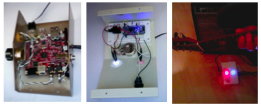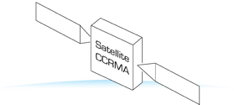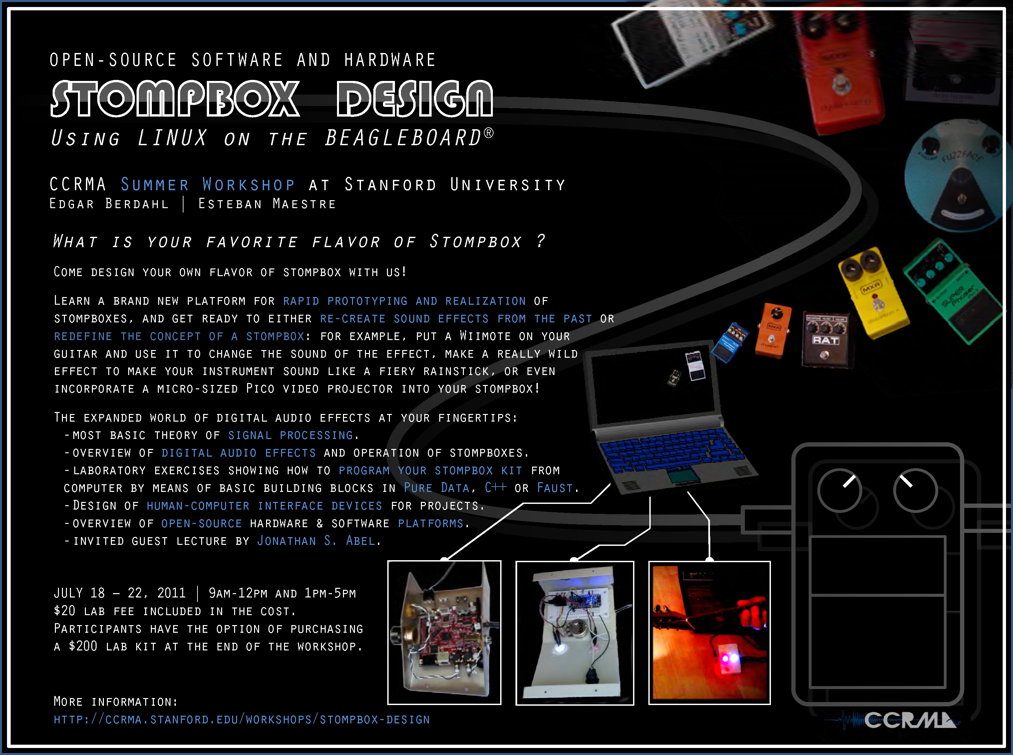Stompbox 2011
Stompbox Design Workshop
CCRMA Summer Workshop 2011
July 18-22
Instructors: Edgar Berdahl eberdahl@ccrma.stanford.edu and Esteban Maestre esteban@ccrma.Stanford.EDU
Contents
COURSE HISTORY AND DESCRIPTION
Description: Come design your own flavor of stompbox at Stanford Universityʼs Stompbox Design workshop. We will teach you a brand new platform for implementing stompboxes that not only enables you to create any sound effects from the past but also promotes the creation of new sound effects. Our resources for new media design are also at your fingertips if you would like to re-design the concept of a guitar stompbox: for example, put a Wiimote on your guitar and use it to change the sound of the effect, or use some LEDs to simulate the glow of vacuum tubes or fire, or even incorporate a micro-sized Pico projector into your stompbox! The expanded world of digital audio effects is at your fingertips because the workshop incorporates:
- Most basic theory of signal processing
- Description of operation of prior stompboxes and digital audio effects
- Laboratory exercise teaching you how to program our own open-source software and hardware platform involving:
- connecting to your stompbox over an Ethernet connection from your laptop
- creating new digital audio effects by connecting together basic building blocks in the graphical
- programming language Pure Data
- building simple button and knob interfaces to Pure Data
- How to program digital audio effects in C++ and/or Faust
- Introduction to human-computer interface devices for projects
Further discussion of open-source hardware and software platforms including Satellite CCRMA. Finally, we will round out the workshop with a roundtable presentation of the stompboxes you create followed by an optional evening jam session for fun.
This workshop is intended for: Musicians interested in exploring new possibilities in digital audio effects in a hands-on and technical way; Makers, engineers, computer scientists, or product designers interested in exploring artistic outlets for their talents and collaborating with musicians; and/or anyone looking to gain valuable skills in basic audio signal processing and human-computer interfaces, with a focus on invention.
Participants are encouraged (but by no means required) to bring their own laptop computers and/or musical instruments.
This workshop was created by Edgar Berdahl and Esteban Maestre in 2011. This workshop uses very similar hardware to the New Music Controllers workshop, but the focus is more on applications to stompbox design and audio signal processing.
COURSE SCHEDULE
We will meet from 9am-5:00pm daily, with mini-breaks at 10:30 and 3:00, and a lunch break from 12-1.
| Date | Morning (9am-12noon) | Afternoon (1:00pm-5:00pm) |
| Monday | Introduction, Overview, Pd basics lecture (incl. one digital effect example), Kit How-To, Lab 0: How To Run Pd | Review lab 0, FX Lecture 1, Lab 1: Making FX In Pd |
| Tuesday | Review Lab 1, FX Lecture 2, Introduction to Electronics--Sensors1 | Lab 2: Controlling an Effect with Real Sensors |
| Wednesday | Lab 2 Review, Interfacing With The Rest Of The World (i.e. making cables, etc.) | Abel Guest lecture, Discuss project ideas, If time start on project |
| Thursday | Maybe FX Lecture 3 (?), Special Topics (e.g. Fun with Wiimotes??) Work on project | Work on project |
| Friday | Work on project | Project presentations 3-4:30PM |
DETAILED DESCRIPTION
Many workshops teach the technical details involved in making music using the Arduino. The NMC workshop goes the extra mile by mentoring participants in evaluating and further developing their own ideas with the help of the Verplank physical interaction design (PID) framework. Participants learn the philosophy and utility underlying the eight interrelated physical interaction design perspectives: idea, metaphor, model, display, error, scenario, task, and control.
The workshop also teaches technical skills for designing musical interactions. The workshop integrates programming, electronics, robotics, audio, and interactive music along with physical interaction design. Hands-on applications using sensors and microprocessors in conjunction with real-time DSP will be explored for making music. Specific technologies will include Arduino platform, processing, Beagle Board, Firmata, and PD and/or Max/MSP for music synthesis. Participants will learn how to use resistive, force-sensitive, capacitative, optical, ultrasound, magnetic, optical, and acceleration sensors. We will also teach students how to make their own sensors with custom geometries constructed out of materials such as conductive fabric, piezoresistive fabric, and copper tape. We will discuss popular controller components such as (multi-)touch screens, TacTex pads, Nintendo Wii, Novint Falcon, and many more. Participants will design and build working prototypes using a kit that can be taken home at the end of the workshop. Many prototypes will be applicable for performance and exhibits. Further issues to be explored will include modes and mappings in computer music, exercises in invention, and applications of sensors and electronics to real-time music. The course will be augmented by a survey of existing controllers and pieces of interactive music.
This workshop is intended for: Musicians or composers interested in exploring new possibilities in interactive music in a hands on and technical way; Anyone looking to gain valuable skills in basic analog and digital electronics, with a focus on invention; Makers, engineers, computer scientists, or product designers interested in exploring artistic outlets for their talents and collaborating with performers and composers.
Worskhop structure: The workshop is an accelerated variant of the Music 250A course. The workshop will consist of half-day supervised lab sessions, and half-day lectures, classroom exercises and discussions. Participants are encouraged (but by no means required) to bring their own laptop computers with any music software/hardware they already use.
WORKSHOP PROJECT
One of the goals of this workshop is to help you get hands-on experience building a musical physical interaction project of your choosing. You are encouraged to work with other workshop participants on the project, particularly those who might have skills that complement your own. Since the workshop is short, it is a good idea to start thinking of ideas during the first lectures and labs; during the second half of the workshop, you will primarily be working on getting a "demo-able" prototype ready for the project presentations on Friday afternoon.
LECTURES
- PID Introduction
- Survey of Physical Interfaces for Music
- Introduction to Electronics
- Sensors
- Microcontroller Architecture
- Interaction Design Framework
LABS
(see links in course schedule)
SOFTWARE
- The lectures will primarily be in Pure Data (Pd) Extended for sound synthesis. We will introduce some other alternatives such as writing plug-ins directly in C/C++ or with Faust.
- The micro SDHC card for your kit will be initialized with Satellite CCRMA so that you can get up and running instantly.
- The Beagle Board platform enables linux to be run on a high-power 720MHz CPU. It can execute floating point operations natively, which is essential for rapid prototyping of audio algorithms.
- The Arduino software could be used to change the Firmata-based firmware that gets data from the Arduino Nano board into Pd.
REFERENCES
FAQ
Project questions
- Can I do ____ for my project?
You can do whatever you would like for your project. Keep in mind that you really only have a few days to work on it, so you might want to focus on one crucial aspect of a larger project that you'd like to have working.
- Can I incorporate my own hardware and software into my project?
Yes, you can, although we have limited time and ability to support hardware and software other than what is introduced in the labs.
- Can I keep the tools we use during the workshop?
If you buy the kit!


